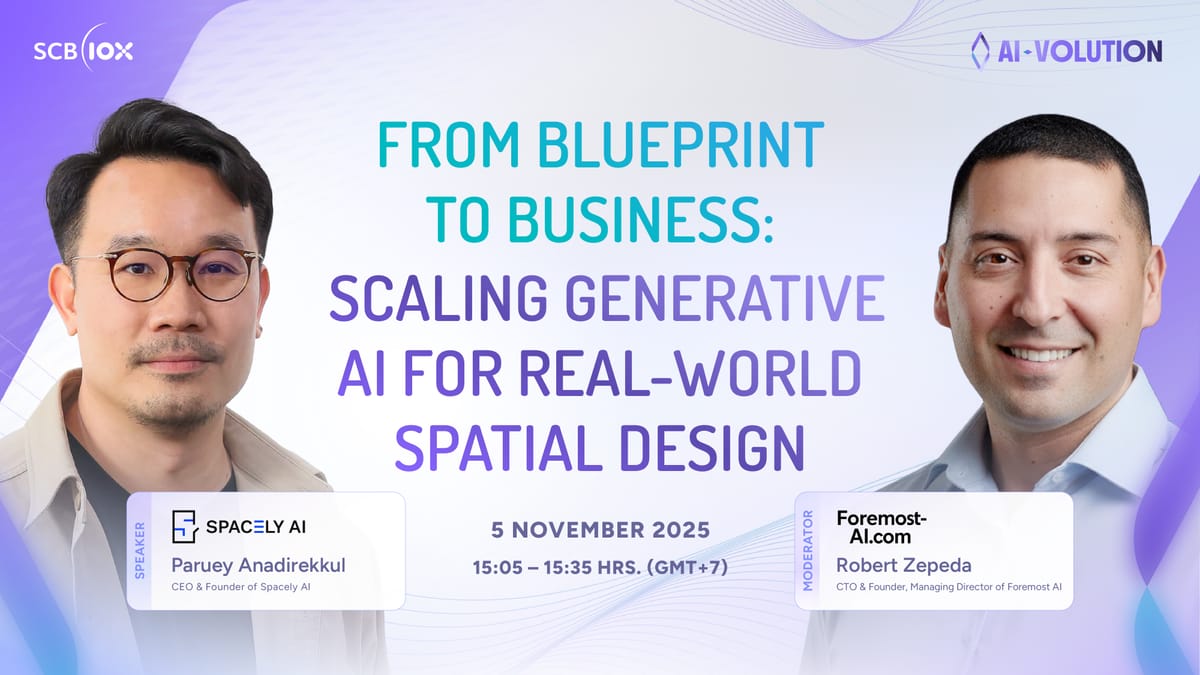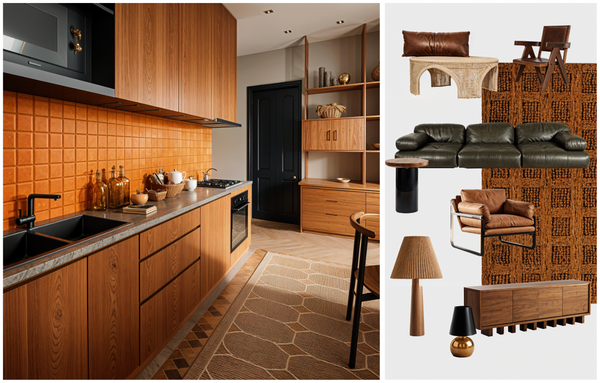From Blueprint to Business: Scaling Generative AI for Real-World Spatial Design
Spacely AI CEO Paruey Anadirekkul shares insights on scaling generative AI from research to real-world spatial design applications serving 1,500+ firms globally.

From Blueprint to Business: Scaling Generative AI for Real-World Spatial Design SPACELY AI
Bridging the Gap Between AI Research and Real-World Design
On November 5th, 2025, I had the privilege of speaking at SCB 10X's AI-VOLUTION event alongside Robert Zepeda, CTO and Founder of Foremost-AI.com. Our conversation explored one of the most critical questions facing the architecture and design industry today: how do you transform cutting-edge AI research into practical tools that actually work in the real world?
At Spacely AI, we've spent the past several years answering exactly that question. Today, we serve over 1,500 architecture firms across 50+ countries, helping them reduce manual work by up to 80% through AI-powered spatial design tools. But getting here wasn't about building the most sophisticated AI—it was about building AI that works in the messy reality of how designers actually operate.
The Real Challenge: Integration
Here's something that might surprise you: the biggest challenge in bringing AI to spatial design wasn't building the AI itself. It was making it work seamlessly with legacy systems, existing workflows, and the ingrained habits of how designers already work.
Because in architecture, AI isn't just about generating something that looks good—it has to fit and function in real space. That's the fundamental difference between art and design. Design isn't just beautiful—it has to work.
This realization shaped everything about how we built Spacely AI. Instead of trying to replace the tools designers already use, we focused on integration—working with the existing ecosystem, not against it. My experience as an Entrepreneur in Residence at SCB 10X taught me that innovation only works when it fits into how people already operate. That's where real, scalable value happens.
Breaking Down the 80% Automation Breakthrough
When we tell people that Spacely AI can reduce manual work by up to 80%, the immediate question is always: how?
We started from first principles. We looked at how 3D floor plans are done today and broke the process down step by step. Then we asked a simple question: which of these steps take the most time, and how can we automate them?
Once we knew the target output—a fully furnished, ready-to-use 3D model—the rest was about choosing the right AI to handle each workflow. That's how we cut up to 80% of manual work, turning hours into minutes.
But here's what's important to understand: we're not replacing the designer. We're replacing the manual, labor-intensive workflow that slows them down. That distinction matters because it's the difference between AI that enhances human creativity and AI that tries (and fails) to replace it.
What Winning Second Runner Up at SketchUp Taught Us
Recently, we placed third in the SketchUp Global Innovation Challenge—the only Asian startup among nine finalists. Beyond the recognition, this achievement proved something crucial: even the biggest players in design software are moving fast to embrace AI.
What we demonstrated wasn't just technical capability. We showed that AI doesn't have to disrupt existing tools—it can enhance them. The industry is ready for this kind of transformation. Not the kind that forces designers to abandon their workflows, but the kind that makes those workflows dramatically more efficient.
Scaling AI in a Conservative Industry: The Business Model That Worked
Achieving 10× revenue growth and securing $1 million in seed funding required making some counterintuitive business model decisions—especially in an industry as traditionally conservative as architecture and interior design.
We built Spacely AI the way modern AI companies scale: results first, usage-based pricing. This model makes sense, especially in a conservative industry where ROI matters most. We focused on a self-serve product, clear measurable results, and went global from day one.
Along the way, winning competitions and raising funding gave us visibility—but the real growth came from aligning value with outcomes.
The Credit Model: What We Learned About Enterprise AI Consumption
One of our most significant decisions was transitioning from unlimited access to a credit-based subscription model. It's a fascinating case study in AI pricing.
The simple truth is: unlimited AI use just isn't sustainable. As a startup, every compute cycle matters, so we had to make the model work for both sides. Moving to credits helped us align cost with results—customers pay for the outcome, not endless usage.
And that's exactly how enterprises are learning to consume AI at scale: pay for value, not volume.
This shift taught us something important about how businesses actually use AI. They don't want infinite access to tools they might use. They want predictable costs tied to measurable outcomes. The credit model delivers exactly that.
Designing for 50+ Countries: The Universal Workflow
Serving clients across 50+ countries means facing diverse design codes, building regulations, and cultural aesthetics. How does our AI adapt to this variation?
The answer surprised even us: the design workflow is surprisingly universal. You design, refine, and then build. That pattern holds true whether you're in Bangkok, Berlin, or Boston.
This means the pain points are the same everywhere. When we solve the workflow challenge, we're solving a global problem.
Of course, culture and style differ—but that's where the beauty of AI comes in. It adapts instantly through prompts, personalizing each space to fit local needs and individual taste. The underlying workflow remains constant, but the output is infinitely customizable.
What Successful AI Adoption Actually Looks Like
We often say that "every architecture firm is rebuilding its workflow around AI." But what does successful adoption actually look like versus the attempts that fail?
Successful adoption starts with starting—but starting small, measurable, and iterative. The winners treat AI as a tool to improve daily work, not as a massive 'transformation project.'
The ones that fail go all-in without clear pain points or realistic expectations. They treat AI implementation like a software installation project rather than a workflow evolution.
Real success comes from operationalizing AI—making it part of everyday habits, not just experiments. And it's important to remember: AI isn't the solution to everything. It's the accelerator for what already works.
The Future: From Operators to Orchestrators
Looking ahead, our automation features will generate multiple floor plan layouts and arrange 3D assets in minutes. This raises an obvious question: how will the role of human designers evolve as AI becomes more capable?
Here's what we believe: AI removes repetition, not creativity.
Designers will move from operators to orchestrators—their real value lies in judgment, taste, and storytelling. We're not replacing creativity—we're removing the friction between imagination and execution.
Imagine a studio that used to handle two or three projects—now delivering twenty or thirty with the same team. Or consider a team that typically spends 6 months on 2-3 projects—what if that could be done in 6 hours?
That level of scale used to sound impossible. We're making it possible.
AI as Co-Designer, Not Replacement
As we expand our roadmap to include features like Bill of Materials generation and real-time collaboration, we're constantly balancing automation with the creative and client-facing sides of design.
We see AI as the co-designer, not the replacement. It automates the manual, time-consuming parts so designers can focus on the creative and client-facing work.
Take the Bill of Materials, for example. Today it's done manually: search for products, build spreadsheets, calculate areas, and add costs. We want to automate that process end-to-end, but the designer still decides what feels right—the materials, textures, and emotional tone of the space.
AI handles efficiency. Humans handle experience.
Lessons for Other Industries: Where Repetition Meets Creativity
Given our success in spatial design AI, what broader lessons can other industries take from our approach?
Any field that mixes repetition and creativity is ripe for AI transformation. Wherever there's a repetitive pain point, that's where AI can deliver instant value—and design is full of those moments.
Spatial design is particularly suited for AI because it's visual, data-driven, and rule-based. There's logic in every layout. For example, a walkway in your bedroom should not be less than 80 centimeters wide—those rules make it ideal for AI to learn, automate, and scale.
The lesson for other industries is simple: start where creativity meets constraint—that's where AI shines.
The Next Breakthrough: AI Building AI
As we wrapped up the conversation, I was asked about my vision for the next major breakthrough in AI-powered spatial design.
Honestly? I don't know exactly what it will look like—but I'd like to help create it.
People talk a lot about superintelligent AI, but I think the real leap is when AI can build other AIs—systems that learn and evolve without humans in the loop.
In spatial design, that means moving beyond design itself. Imagine AI that can not only design, but actually build an entire building end to end—from concept to construction.
Enterprises should prepare by becoming the orchestration layer—guiding how these systems work together and who owns the models behind them.
And we'll likely see AIs specializing—one mastering bathroom layouts, another commercial kitchens. The future won't be one AI doing everything. It'll be a network of expert AIs, building the world together.
What This Means for You
If you're a designer, architect, or real estate professional reading this, the message is clear: AI isn't coming to replace you. It's coming to give you superpowers.
The firms that embrace AI early—that start small, measure results, and operationalize these tools into daily workflows—will have an enormous competitive advantage. Not because their AI is better, but because their designers can focus on what humans do best: creative judgment, client relationships, and the emotional storytelling that makes spaces meaningful.
If you're an enterprise decision-maker evaluating AI implementation, remember: start where the pain is most acute. Find the repetitive workflows that slow your team down. That's where AI delivers immediate, measurable value. Build from there.
And if you're an entrepreneur or technologist in any industry, look at what we've done in spatial design as a blueprint: find the intersection of creativity and constraint, build for integration rather than disruption, and always remember that the goal isn't replacing humans—it's removing the friction that keeps them from doing their best work.
About the AI-VOLUTION Event
The conversation at SCB 10X's AI-VOLUTION event on November 5th, 2025, explored how generative AI is transforming traditional industries. Alongside Robert Zepeda from Foremost-AI.com, we discussed the practical challenges, business model decisions, and future opportunities in bringing AI from research labs to real-world applications.
For architecture and design professionals interested in learning more about how AI can transform your workflows, visit spacely.ai to see our tools in action.




